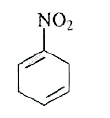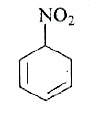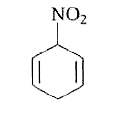Reduction of nitrobenzene with H2 in presence of platinum gives nitrosobenzene––––––––––––––––.
To solve the question regarding the reduction of nitrobenzene with hydrogen (H₂) in the presence of platinum, we need to analyze the reaction step by step.
1. Identify the Reactants:
- The reactant in this reaction is nitrobenzene (C₆H₅NO₂). Nitrobenzene is an aromatic compound with a nitro group (-NO₂) attached to a benzene ring.
2. Understand the Reaction Conditions:
- The reaction involves the use of hydrogen gas (H₂) and a platinum catalyst. Platinum is a noble metal that facilitates the reduction process.
3. Reduction Process:
- In the presence of hydrogen and platinum, nitrobenzene undergoes reduction. The nitro group (-NO₂) is converted to an amine group (-NH₂).
4. Product Formation:
- The reduction of nitrobenzene with H₂ in the presence of platinum leads to the formation of aniline (C₆H₅NH₂), which is an aromatic amine. The reaction can be summarized as follows:
C6H5NO2+6H2Pt−→C6H5NH2+2H2O
5. Conclusion:
- The statement in the question that the reduction of nitrobenzene with H₂ in the presence of platinum gives nitrosobenzene is incorrect. The correct product is aniline.
Final Answer:
The reduction of nitrobenzene with H₂ in the presence of platinum gives aniline, not nitrosobenzene.
---
- The reactant in this reaction is nitrobenzene (C₆H₅NO₂). Nitrobenzene is an aromatic compound with a nitro group (-NO₂) attached to a benzene ring.
- The reaction involves the use of hydrogen gas (H₂) and a platinum catalyst. Platinum is a noble metal that facilitates the reduction process.
- In the presence of hydrogen and platinum, nitrobenzene undergoes reduction. The nitro group (-NO₂) is converted to an amine group (-NH₂).
- The reduction of nitrobenzene with H₂ in the presence of platinum leads to the formation of aniline (C₆H₅NH₂), which is an aromatic amine. The reaction can be summarized as follows:
C6H5NO2+6H2Pt−→C6H5NH2+2H2O
- The statement in the question that the reduction of nitrobenzene with H₂ in the presence of platinum gives nitrosobenzene is incorrect. The correct product is aniline.
The reduction of nitrobenzene with H₂ in the presence of platinum gives aniline, not nitrosobenzene.
Topper's Solved these Questions
- ORGANIC COMPOUNDS CONTAINING NITROGENBOOK - ICSECHAPTER - ORGANIC COMPOUNDS CONTAINING NITROGENEXERCISE - EXERCISE (PART-II DESCRIPTIVE QUESTIONS- VERY SHORT ANSWER QUESTIONS )
89 Videos
- ORGANIC COMPOUNDS CONTAINING NITROGENBOOK - ICSECHAPTER - ORGANIC COMPOUNDS CONTAINING NITROGENEXERCISE - EXERCISE (PART-II DESCRIPTIVE QUESTIONS- SHORT ANSWER QUESTIONS )
92 Videos
- ORGANIC COMPOUNDS CONTAINING NITROGENBOOK - ICSECHAPTER - ORGANIC COMPOUNDS CONTAINING NITROGENEXERCISE - ISC EXAMINATION QUESTIONS ( PART-II DESCRIPTIVE QUESTIONS)
33 Videos
- ISC QUESTION PAPERBOOK - ICSECHAPTER - ISC QUESTION PAPEREXERCISE - PART-II(SECTION-B)
74 Videos
- P-BLOCK ELEMENTSBOOK - ICSECHAPTER - P-BLOCK ELEMENTSEXERCISE - SOURCE BASED QUESTIONS
10 Videos
Similar Questions
Knowledge Check
Birch reduction of nitrobenzene will produce :
A B
B C
C D
D
Clemmensen reduction of a ketone is carried out in presence of
AH2 with Pd as catalystBglycol with KOHCLiAlH4 in etherDZn−Hg with HClClemmensen reduction of a ketone is carried out in presence of
AH2 with Pd as catalystBglycol with KOHCLiAlH4 in etherDZn−Hg with HCl
Reduction of water potential due to presence of solute is
View SolutionAn isocyanide on reduction with hydrogen in the presence of platinum gives :
View SolutionElectrolytic reduction of nitrobenzene in weakly acidic medium gives .
View SolutionElectrolytic reduction of nitrobenzene in weakly acidic medium gives .
View SolutionThe reduction of 4−octyne withH2 in the presence of Pd/CaCO3− quinoline gives-
View Solution
